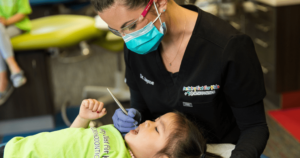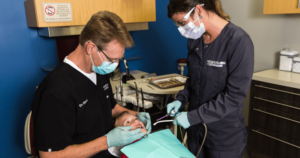The 3 Best Ways for Children to Earn Whiter Teeth
A healthy, luminous smile is something that everyone values. Here’s some of the best ways for your child (and you) to earn healthier, whiter teeth without having to get expensive bleaching treatment.
What Causes Tooth Discoloration?
There are a few things that cause tooth discoloration in children. Extrinsic discoloration (discoloration of the outer layer of tooth) is the most common form of tooth discoloration, and it’s caused by drinking sugary beverages or cola, and eating food that stains teeth. Age related tooth discoloration is caused by chips in teeth or any damage to the tooth pulp, which discolors the dentin.
1 – Drink More Water
Water helps naturally keep teeth clean by rinsing sugar and food debris off of the surface of teeth, which fuels cavity-growth by providing bad bacteria with the fuel it needs to spread and cause tooth decay and cavities. Water also helps keep saliva production steady, which naturally cleans teeth and combats halitosis.
2 – Avoid the Causes of Tooth Discoloration
One of the best ways for your child to keep a whiter smile is by avoiding the causes of tooth discoloration. Try to limit or cut back entirely on highly acidic foods and drinks, sugary beverages like cola or sweetened coffee drinks, tomato sauce and dark juices. All of these foods can discolor teeth, and lead to a less luminous smile.
3 – Brush and Rinse after Every Meal
You can empower your child to fight tooth decay and get a healthier smile by helping them get into a proper oral health routine, which means brushing twice per day for two minutes at a time, and flossing once per day. A healthy brushing routine helps keep the surface of teeth clean by removing food debris and any small stains from the prior meal. Flossing helps remove food from the hard-to-reach areas between teeth, which account for 1/3 of the total surface area of teeth.
When Should My Child Begin Whitening?
Your child shouldn’t use any teeth-whitening product on their teeth until their final adult tooth has emerged – which is usually around age 12 or 13. Additionally, your child needs to wait until their enamel has fully calcified BEFORE beginning any whitening treatment, which usually takes 2 years after an adult tooth emerges. If your child uses a whitening treatment before their adult teeth come in, then they risk breaking down their tooth enamel and damaging their gum tissue.
Visit Our Office
Before beginning any whitening treatment at home, it’s best to consult with your child’s pediatric dentist first. If your family doesn’t have a pediatric dentist, then visit our office. We treat children of all ages, and help empower families to earn healthier smiles every day.


